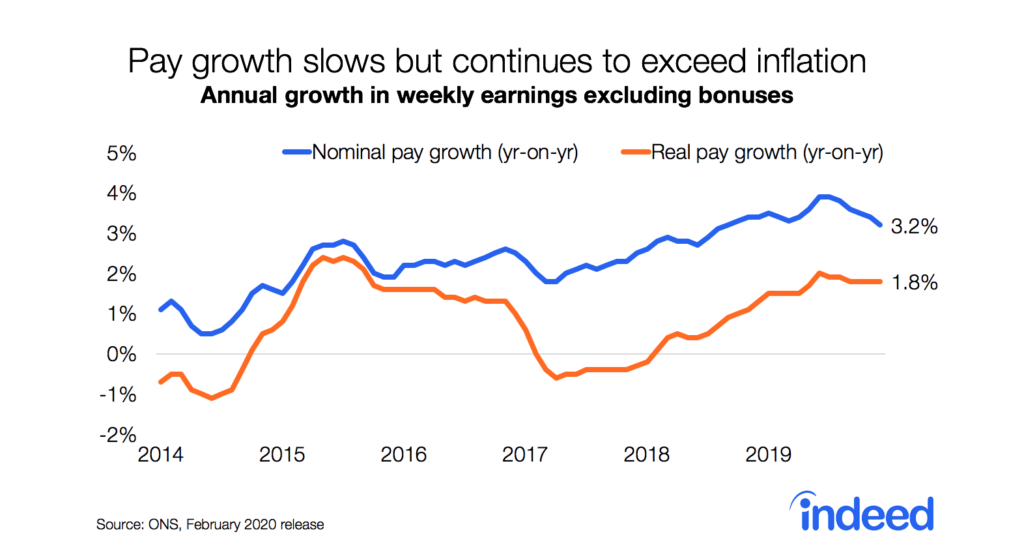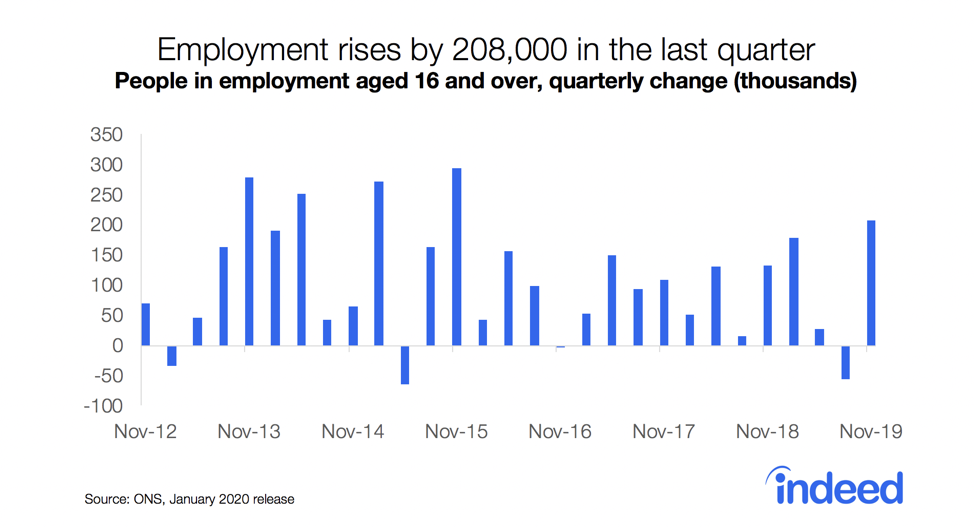Key points
- No city has yet recovered to its pre-lockdown job postings trend.
- The slow recovery is driven by fewer postings in local services, including food, retail, and other businesses exposed to Covid-related restrictions, jobs typically found on high streets.
- Employment opportunities in local services are down most in places where more people work from home and fewer people are returning to the high street, which means finding these kinds of jobs may be hard as restrictions are reintroduced.
Social distancing and the full national lockdown introduced in March sent the UK labour market into a freeze. As businesses struggled to cope, job postings on Indeed declined dramatically, reaching their low point at the beginning of June when they were down 61% compared with last year’s trend. (See methodology for an explanation of how this analysis measures posting trends.) Despite hiring picking up since then, it is still far below its pre-Covid levels, with some places hit especially hard.
Labour market recovery is slow
The UK job posting trend on Indeed fell 46% from last year at the start of October and was down in all cities and large towns. Some places were performing better than others though. In Chatham, early October job postings were just 7% below last year’s trend, in Stoke 17% below and in Burnley 18%. But the labour market is recovering much more slowly in many cities. Job postings in Aberdeen were a full 75% below last year’s trend, and seven more cities, including London, were still off more than 50%.
Hiring in local services businesses is lagging
The slow recovery of job postings is concentrated in specific sectors. Local service jobs that involve selling directly to consumers are among those struggling most. These include jobs in such sectors as food, retail, arts and leisure that are exposed to Covid-related restrictions. This category of jobs registered the largest postings drop between March and May. At the trough, the category was down 70% from last year’s trend and was still off 48% at the start of October. This contrasts with the stronger performance of job postings in sectors such as health and education, which have been relatively sheltered from COVID-19 and were only 27% below last year’s trend at the beginning of October.
Local services jobs tend to be low in pay. Nevertheless, they are a crucial source of income for many people. The bad news is that low earners, who represent a growing share of jobseekers, face rising competition for low-paid jobs as opportunities dry up.
Working from home and low city-centre footfall put local services jobs at risk
The slow recovery in local services job postings is closely linked to the weak rebound of footfall. In large cities, fewer people have returned to city centres, unlike in some smaller cities – such as Birkenhead, Chatham and Hull – where footfall is back at pre-COVID-19 levels or higher.
In turn, the rate of working from home plays a key role in the relationship between job postings and footfall. Covid has forced a decoupling of the office and the high street, causing the flow of customers for centrally located businesses to shrivel. People working in front of their computers in their flats all day are not likely to pop to the high street for lunch. Large cities like London, Manchester and Edinburgh are among the places where working from home has been most feasible during the pandemic, based on the occupational structure of employment. Moreover, the share of job descriptions that currently mention working from home is higher in these cities. So it’s not surprising they are among the places where job postings in local services have bounced back most feebly.
London is close to the extreme in all these measures. In the third quarter, some 10.7% of London job postings mentioned working from home. And, at the start of October, London’s overall job posting count was 52% below last year’s trend, while local services job postings were down 57%.
Tough winter ahead as new restrictions are introduced
With the reintroduction of working-from-home guidance and stricter social distancing measures, the prospect of a recovery in local services job postings seems distant, especially in larger cities. While the changes to the Job Support Scheme introduced last week will help prevent more people from losing their jobs, those who have already been made redundant will find it hard to find work. Renewed lockdown restrictions are likely to slow creation of high street jobs further and that probably won’t change until large numbers of people return to city-centre work sites. As the nation adjusts to new ways of working, it is possible that local services jobs will take longer to recover, look different or move to entirely new places, with profound implications for workers.
This post was published concurrently on the Centre for Cities blog.
Methodology
We aggregated job postings by Primary Urban Area – a measure of the built-up area of a city – based on the location of the job. We used Primary Urban Areas in our analysis because they provide a consistent measure of economic activity in urban areas across the UK. A complete list is available here.
To measure total job postings trends, we calculated the seven-day moving average of the number of job postings on Indeed. We indexed each day’s seven-day moving average to the start of that year (1 February 2020 = 100 for 2020 data, and so on). For each city, we report how the trend in total job postings this year differs from last year, in order to focus on recent changes in labour market conditions due to COVID-19. For example, if job postings increased 30% from 1 February 2019 to 2 October 2019, but only 20% from 1 February 2020 to 2 October 2020, then the index would have risen from 100 to 130 in 2019 and 100 to 120 in 2020. The year-to-date trend in job postings would therefore be down 7.7% on 2 October (120 is 7.7% below 130) in 2020 relative to 2019.
We defined local services as occupations in businesses that tend to sell directly to consumers and typically serve a very local market, including food preparation and service, driving, retail, cleaning, construction, real estate, arts and leisure. Work-from-home postings are those that contain keywords related to working from home or remote work in the job title or job description. This post is based on publicly available information on the Indeed UK website. It is limited to the UK, is not a projection of future events and includes both paid and unpaid job solicitations.






